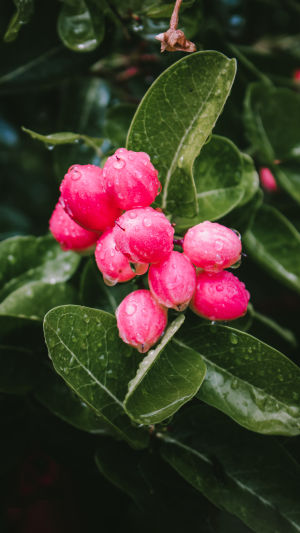The plant you are describing is the Bengal Currant, a species belonging to the dogbane family (Apocynaceae) under the genus Thevetia. It is an evergreen shrub with forked thorns on the dry branches, reaching up to 2.5 centimeters in length.
The branches are gray and hairless. The leaves are opposite, leathery, broadly ovate to nearly circular, 3-4 centimeters long and 2-2.5 centimeters wide, with a short pointed tip at the apex and a rounded or blunt base. Both sides of the leaves are smooth, and the leaf veins are flattened on both surfaces.
The flowers are white or slightly tinged with rose red. The calyx has five lobes, and the inner surface at the base has glands. The corolla tube is 2 centimeters long, with a softly hairy inner surface. Five corolla lobes are shorter than the corolla tube and overlapping to the right. There are five stamens attached to the corolla tube. The ovary has two chambers, each containing multiple ovules.
The fruit is spherical or ellipsoidal, measuring 1.5-2.5 centimeters in length and 1-2 centimeters in diameter. When mature, it turns black. The plant is native to India and other regions, including the Konkan range of the Western Ghats in Maharashtra and Goa. It also grows naturally in temperate conditions in the Himalayas of India and Nepal, at altitudes ranging from 30 to 1,800 meters (98 to 5,906 feet).
In addition to India, it can be found in other South Asian countries such as Sri Lanka, Pakistan, Nepal, Afghanistan, and Bangladesh.
The Bengal Currant is visually appealing, with its cherry-like appearance. However, the fruit's flesh is extremely sour, even more so than that of lemons. The ripe fruit is black, with a diameter typically ranging from 1 to 2 centimeters. Despite its attractive appearance, it is not commonly consumed directly due to its intense sour taste. Processing is often done before consumption.
When the fruit is cut open, the yellow portion inside is the seed. The smooth and hairless skin and its cherry-like size and appearance add to its aesthetic value.
In embracing nature, the Bengal Currant reveals its unique beauty and vitality. This evergreen shrub not only thrives in places like India but also flourishes naturally in the temperate conditions of the Himalayas. Its white or rose-red flowers, tangy black fruits, and charming cherry-like appearance make it stand out in the natural world.
Despite its fruit being more sour than lemons, the Bengal Currant maintains its value for visual appreciation and consumption after processing. This plant is not just a part of Indian culture but also a symbol of the marvels of life in nature, encouraging an appreciation for the beauty of the natural world.





